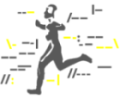





Search | Sitemap | Navigation |  |
|
||||||||||||||||||||||||||
|
||||||||||||||||||||||||||
|
||||||||||||||||||||||||||
|
Modelling Migraine Aura
Computational investigations of cognitive disorders become increasingly important. "The last decade has witnessed an increasing interest in computational investigations of brain functioning. It is only natural to ask how such neural modeling may be harnessed to investigate the pathogenesis or potential treatment of brain disorders, and in what way may computational methods complement more traditional research methodologies."
Quote from the introduction of the book "Disorders of Brain, Behavior and Cognition: the Neurocomputational Perspective" Prog Brain Res 121, 1999.
Migraine hallucinations provide routes both to migraine etiology and the neural mechanisms of normal brain function. Neural network models have become sophisticated enough to constrain and validate possible underlying cortical circuitry. The main goals of current research in modeling are devoted to understanding cortical susceptibility to focal symptoms in terms of neural circuitry and new approaches are sought in a way that will allow them to be applied to a broad class of neurological diseases. It is hoped that these techniques open clinical possibilities to study pathology and develop new strategies for therapy and rehabilitation.
Models
Various models wave been suggested to explain the symptoms of migraine aura. Most are concerned with visual symptoms but the results can be transfered to other sensory disturbances. [more]

A simulation showing a traveling wave in gyrate cortex and the corresponding visual field defect. © 2005 Jan Tusch and Markus Dahlem
Appendices referred to in the section Models
The neural network models mimic brain functioning. We introduce the concepts of Neural Networks, Brain Maps, and Nonlinear Dynamics, i.e., concepts related to mathematical and biophysical inquiry of the aura . [more]
Simulations
Simulations with network models of the aura allow the patient to virtually re-experience their disorders. Preliminary results indicate that such networks provide realistic simulations that can be matched by patients against their visual symptoms. [more]
Typical visual aura symptom, the so-called fortification spectrum.
References
Dahlem MA, Engelmann R, Lowel S, Muller SC. Does the migraine aura reflect cortical organization? Eur J Neurosci 2000; 12: 767-770.
Lashley K. Patterns of cerebral integration indicated by scotomas of migraine. Arch Neurol Psychiatry 1941; 46: 331-339.
Reggia JA, Montgomery D. A computational model of visual hallucinations in migraine. Comput Biol Med 1996; 26: 133-141.
Richards W. The fortification illusions of migraines. Sci Am 1971; 224: 88-96.
Schwartz EL. A quantitative model of the functional architecture of human striate cortex with application to visual illusion and cortical texture analysis. Biol Cybern 1980; 37: 63-76.
Author: Markus Dahlem
Last modification of this page: April 11, 2006
 Top of the page
Top of the page| · | News |
| · | Medical Professionals |
| · | Medical Studies |
| · | Simulations |
Copyright © 2005 Migraine Aura Foundation, All rights reserved. Last modification of this site: August 25, 2006
Thanks to: RAFFELT MEDIENDESIGN and GNU software | webmaster@migraine-aura.org
http://migraine-aura.org/EN/Modelling_Migraine_Aura.html



